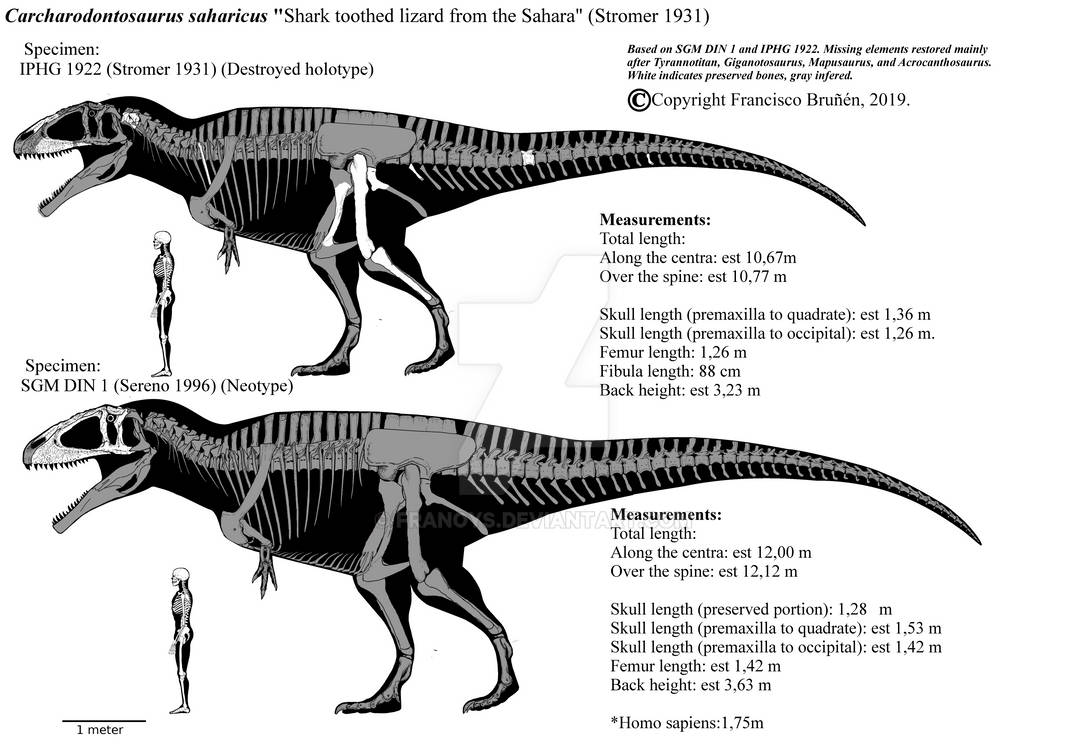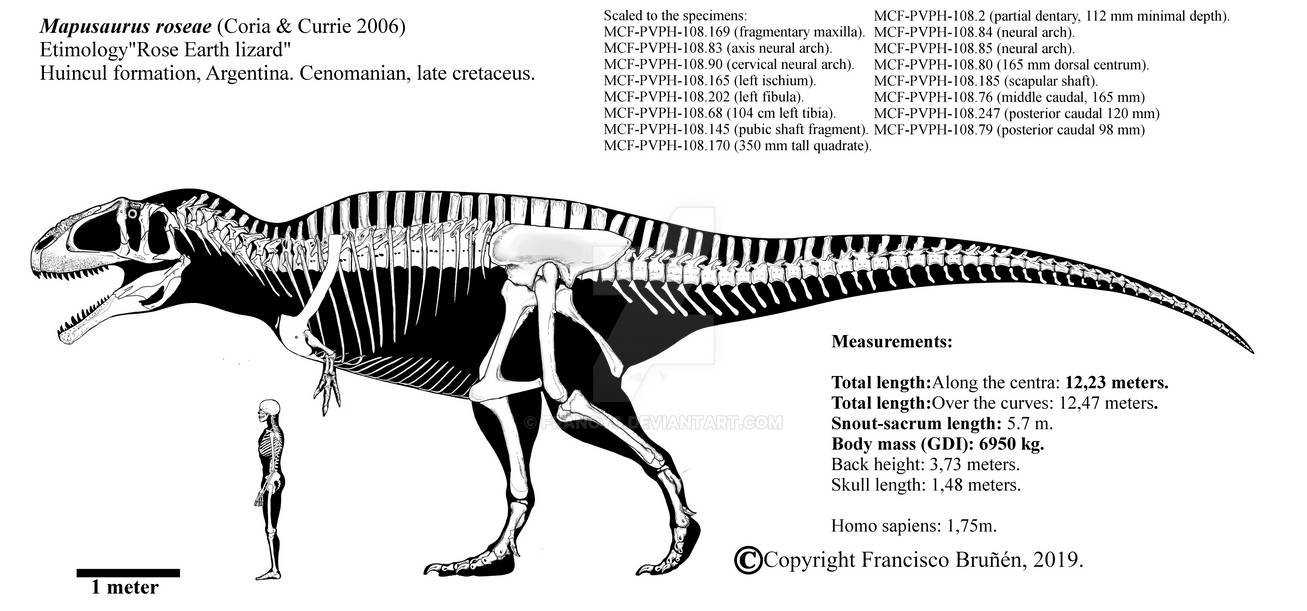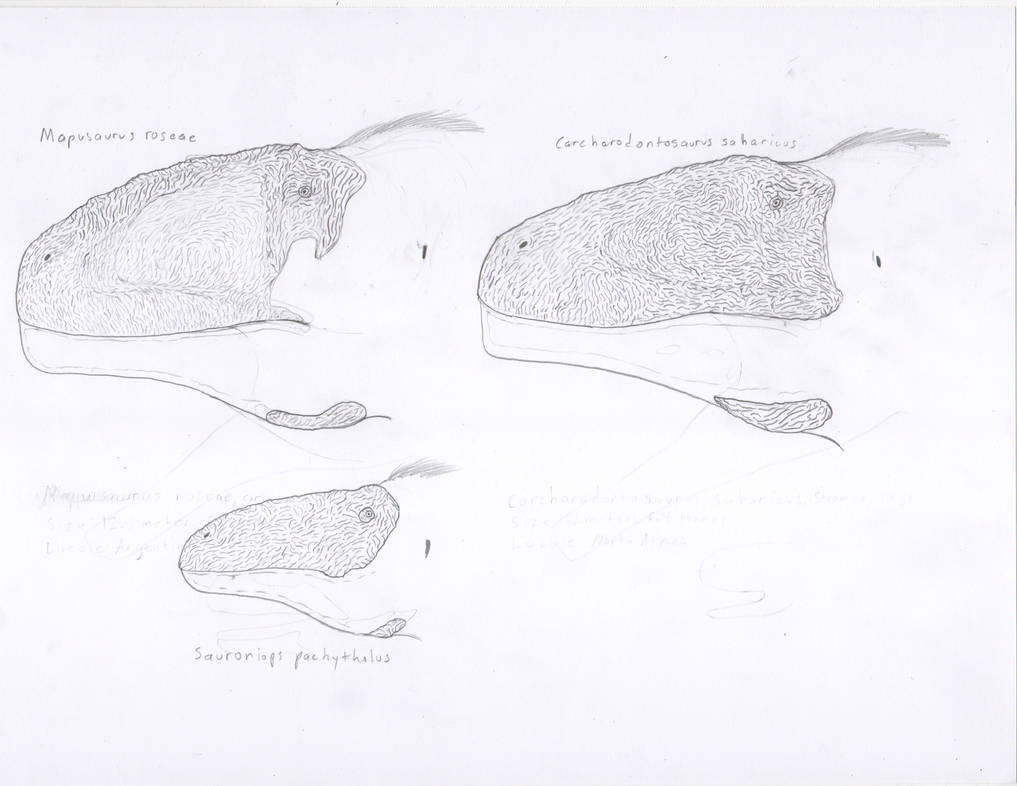ShopDreamUp AI ArtDreamUp
Deviation Actions
So as we all know, keratin is a very AWESOME thing. It's the thing that gives us our fingernails. It's the stuff that makes up a rhino's rhine and the pangolin's scales, and it is is EVERYWHERE, and I mean EVERYWHERE. A whole bunch of tetrapods that aren't amphibians have keratin in some parts of their body. The claws of a lizard, the beak of a bird, and the quills of a porcupine are all excellent examples, but we want to talk about today is keratin in non-avian dinosaurs.
A lot of you are probably familiar with this concept. After all, many people have seen dinosaurs restored with keratinous extensions, especially the skull tops of theropods. Others may have seen Triceratops and Pachycephalosaurus being portrayed with a keratin head covering in Saurian, a highly anticipated video game on accurate dinosaurs. Then there is the recent D. horneri paper suggesting tyrannosaurs were not lipped (They most likely were), portraying a keratin head and face covering on the skull of a very new species of tyrannosaur called Daspletosaurus horneri. However, I want to delve in deeper into the world of keratin coverings on theropods, because despite the fact that we know most large theropods have a covering of keratin on the top of their skull, there are other kinds that take this keratin extension a whole step further.
First of all, we need to know the evidence for a keratin covered area of the skull. Many animals that do have a keratin covered spot on their head have striation or maybe pore marks on that part. That suggests the area was covered in keratin in life. Some good examples for this are modern hoofed mammals and rhinos
www.skullsunlimited.com/userfi…
boneclones.com/images/store-pr…
Another example are bird beaks. Most birds have beaks marked with striations, suggesting a keratin coating, which is true. Crocodilians also have a HIGHLY rugose skull, which supports their tightly wrapped, cornified skin.
www.boneroom.com/uploads/4/8/1…
d2fbmjy3x0sdua.cloudfront.net/…
boneclones.com/images/store-pr…
So how does this affect non-avian theropod dinosaurs? Well, if we follow these modern examples, then we should know what the extent and texture of a keratin covered area on a theropod's face.
Looking at theropod skulls, it seems obvious that a keratin coating of some sort is present in quite a few types. Nearly all large theropods posses a "crest" display that would have been covered in keratin in life. Some exceptions to this are non-spinosaurid megalosaurs and Allosaurus, which seems to have had crests that were either covered in keratin or in flesh. However, there are quite a few that show signs of the entire face being covered in keratin or cornified skin. One example are spinosaurs, which have rugosed snouts like crocodilians, suggesting a face covered in tough, tightly wrapped skin similar to keratin with sensors lining it. There are other theropods however that take this to the extreme.
Armored Sosigs
Abelisaurs are probably a good example of a creature with highly rugose faces in life. The skulls of abelisaurs are very gnarly indeed, and are very similar in terms of texture to a crocodilian. We even had evidence of facial impressions from Carnotaurus, but they were accidentally destroyed. However, we do have some descriptions saying that the facial scales were "irregular" and "differered from the main body scales". It is very possible that they were in fact not scales, but keratinized skin. Crocodilians were once thought to have had scaly heads, but recent research suggests they are actually cracked, toughened skin. It is definitely possible that the scientists mistook the keratin impressions for scales, suggesting a gnarly looking mug to Carnotaurus's face. Many other abelisaurs also have a pretty gnarly mug, such as Majungasaurus and Rugops, all indicating at a armor-faced mug.
static3.wikia.nocookie.net/__c…
dinonews.net/wiki/images/3/32/…
And here is what they would have looked like in life.

As for why they had such thickened skulls, they might have bore several uses. They could have been used as display, as seen in modern wood storks, or maybe protection against the hot sun, like wood storks. A few people have even said Carnotaurus may have been an armored missile, ramming right into its prey at top speed, breaking bone. Albeit, it sounds quite elaborate, but it shouldn't be totally discounted. Carnotaurus has a strong skull and neck that could help it withstand collision, and the keratin covering could have aided it in such. It could also slow down to a more mild, but still bone shattering speed to reduce the amount of force on impact. Whatever the case, abelisaurs were very much, scaly doggos or cattos, but they weren't the only theropods with super tough muzzles.
Revisiting Carcharodontosaurus
As you may know if you have been with me since the very beginning, I made a deviation of three theropods showing off the various styles in flesh display that has been suggested in an SVP paper. Carcharodontosaurus was in that drawing.

I've given some thought to this look, and I now have serious doubts on many theropods looking like this. While Allosaurus probably did have fleshy crest, I'm not sure what the heck Sinraptor's skull indicates, but it probably wasn't caruncles like shown here. As for Carcharodontosaurus, let me just say that this massive carnivore probably didn't have a flesh covered snout, in fact quite the contrary. If you want to know what I mean, just look at the skull of Carcharodontosaurus
public-ch3301.files.1drv.com/y…

(Skeletal above by Franoys)
The skull of Carcharodontosaurus is not only big, its gnarly. The face is almost completely covered with striations and pits, something that rivals even the abelisaurs in terms of roughness. It makes the skull of Daspletosaurus horneri look baby smooth by comparison, and it isn't the only carcharodontosaur to show this. Mapusaurus for instance shows the same thing, albeit the impressions are smaller and finer.
citeseerx.ist.psu.edu/viewdoc/… (Page 7)
Sauroniops isn't known from much, but the fragment we have rivals the abelisaurs and even pachycephalosaurs in terms of roughness and texture and what have learned from keratin coverings? That they leave marks in the bone hinting at their texture and depth. So what does this mean for carcharodontosaurs that show evidence for this texture?
ARMOR FACED SHARKTOOTHED LIZARDS BOI!!!!!!!!

As for the reason why they evolved this remains unsolved to me anyway. While Carcharodontosaurus and Mapusaurus show evidence of this texture, the other giant shark-tooth lizards, Giganotosaurus and Tyrannotitan, have the typical theropod skull texture. A possibility as to why might be social behaviour. Mapusaurus is known to have lived in mobs as indicated by a bone-bed containing several individuals. Perhaps a lot of infighting was going on between the mob's inmates, and so Mapusaurus has evolved a rugged face texture to cope with the constant biting. While we do not have any direct evidence for the social structure of Carcharodontosaurus, perhaps they were living in mobs as well, and since it had the more rugged face texture, it may have been living in larger, more violent groups, perhaps hinting at large mobs of Carcharodontosaurus, roaming the brackish water floodplains of North Africa, seeking out large prey to take on.
So, from what we have seen, keratin extensions on theropods is common, but an entire face covered in thickened skin or tough keratin is pretty rare among theropods. Why do only very few theropods have such rugose textures? Well, at the moment, we do not know, but as new evidence shows up, we might be able to solve the mystery of the armor-face theropods.
A lot of you are probably familiar with this concept. After all, many people have seen dinosaurs restored with keratinous extensions, especially the skull tops of theropods. Others may have seen Triceratops and Pachycephalosaurus being portrayed with a keratin head covering in Saurian, a highly anticipated video game on accurate dinosaurs. Then there is the recent D. horneri paper suggesting tyrannosaurs were not lipped (They most likely were), portraying a keratin head and face covering on the skull of a very new species of tyrannosaur called Daspletosaurus horneri. However, I want to delve in deeper into the world of keratin coverings on theropods, because despite the fact that we know most large theropods have a covering of keratin on the top of their skull, there are other kinds that take this keratin extension a whole step further.
First of all, we need to know the evidence for a keratin covered area of the skull. Many animals that do have a keratin covered spot on their head have striation or maybe pore marks on that part. That suggests the area was covered in keratin in life. Some good examples for this are modern hoofed mammals and rhinos
www.skullsunlimited.com/userfi…
boneclones.com/images/store-pr…
Another example are bird beaks. Most birds have beaks marked with striations, suggesting a keratin coating, which is true. Crocodilians also have a HIGHLY rugose skull, which supports their tightly wrapped, cornified skin.
www.boneroom.com/uploads/4/8/1…
d2fbmjy3x0sdua.cloudfront.net/…
boneclones.com/images/store-pr…
So how does this affect non-avian theropod dinosaurs? Well, if we follow these modern examples, then we should know what the extent and texture of a keratin covered area on a theropod's face.
Looking at theropod skulls, it seems obvious that a keratin coating of some sort is present in quite a few types. Nearly all large theropods posses a "crest" display that would have been covered in keratin in life. Some exceptions to this are non-spinosaurid megalosaurs and Allosaurus, which seems to have had crests that were either covered in keratin or in flesh. However, there are quite a few that show signs of the entire face being covered in keratin or cornified skin. One example are spinosaurs, which have rugosed snouts like crocodilians, suggesting a face covered in tough, tightly wrapped skin similar to keratin with sensors lining it. There are other theropods however that take this to the extreme.
Armored Sosigs
Abelisaurs are probably a good example of a creature with highly rugose faces in life. The skulls of abelisaurs are very gnarly indeed, and are very similar in terms of texture to a crocodilian. We even had evidence of facial impressions from Carnotaurus, but they were accidentally destroyed. However, we do have some descriptions saying that the facial scales were "irregular" and "differered from the main body scales". It is very possible that they were in fact not scales, but keratinized skin. Crocodilians were once thought to have had scaly heads, but recent research suggests they are actually cracked, toughened skin. It is definitely possible that the scientists mistook the keratin impressions for scales, suggesting a gnarly looking mug to Carnotaurus's face. Many other abelisaurs also have a pretty gnarly mug, such as Majungasaurus and Rugops, all indicating at a armor-faced mug.
static3.wikia.nocookie.net/__c…
dinonews.net/wiki/images/3/32/…
And here is what they would have looked like in life.

As for why they had such thickened skulls, they might have bore several uses. They could have been used as display, as seen in modern wood storks, or maybe protection against the hot sun, like wood storks. A few people have even said Carnotaurus may have been an armored missile, ramming right into its prey at top speed, breaking bone. Albeit, it sounds quite elaborate, but it shouldn't be totally discounted. Carnotaurus has a strong skull and neck that could help it withstand collision, and the keratin covering could have aided it in such. It could also slow down to a more mild, but still bone shattering speed to reduce the amount of force on impact. Whatever the case, abelisaurs were very much, scaly doggos or cattos, but they weren't the only theropods with super tough muzzles.
Revisiting Carcharodontosaurus
As you may know if you have been with me since the very beginning, I made a deviation of three theropods showing off the various styles in flesh display that has been suggested in an SVP paper. Carcharodontosaurus was in that drawing.

I've given some thought to this look, and I now have serious doubts on many theropods looking like this. While Allosaurus probably did have fleshy crest, I'm not sure what the heck Sinraptor's skull indicates, but it probably wasn't caruncles like shown here. As for Carcharodontosaurus, let me just say that this massive carnivore probably didn't have a flesh covered snout, in fact quite the contrary. If you want to know what I mean, just look at the skull of Carcharodontosaurus
public-ch3301.files.1drv.com/y…

(Skeletal above by Franoys)
The skull of Carcharodontosaurus is not only big, its gnarly. The face is almost completely covered with striations and pits, something that rivals even the abelisaurs in terms of roughness. It makes the skull of Daspletosaurus horneri look baby smooth by comparison, and it isn't the only carcharodontosaur to show this. Mapusaurus for instance shows the same thing, albeit the impressions are smaller and finer.
citeseerx.ist.psu.edu/viewdoc/… (Page 7)

Sauroniops isn't known from much, but the fragment we have rivals the abelisaurs and even pachycephalosaurs in terms of roughness and texture and what have learned from keratin coverings? That they leave marks in the bone hinting at their texture and depth. So what does this mean for carcharodontosaurs that show evidence for this texture?
ARMOR FACED SHARKTOOTHED LIZARDS BOI!!!!!!!!

As for the reason why they evolved this remains unsolved to me anyway. While Carcharodontosaurus and Mapusaurus show evidence of this texture, the other giant shark-tooth lizards, Giganotosaurus and Tyrannotitan, have the typical theropod skull texture. A possibility as to why might be social behaviour. Mapusaurus is known to have lived in mobs as indicated by a bone-bed containing several individuals. Perhaps a lot of infighting was going on between the mob's inmates, and so Mapusaurus has evolved a rugged face texture to cope with the constant biting. While we do not have any direct evidence for the social structure of Carcharodontosaurus, perhaps they were living in mobs as well, and since it had the more rugged face texture, it may have been living in larger, more violent groups, perhaps hinting at large mobs of Carcharodontosaurus, roaming the brackish water floodplains of North Africa, seeking out large prey to take on.
So, from what we have seen, keratin extensions on theropods is common, but an entire face covered in thickened skin or tough keratin is pretty rare among theropods. Why do only very few theropods have such rugose textures? Well, at the moment, we do not know, but as new evidence shows up, we might be able to solve the mystery of the armor-face theropods.
A Note on Man's Arrogance.
Hello everyone.
So, as you all know, I've been doing a Godzilla fanfic for quite a while now, and it's been progressing quite rapidly.
However, after going through the story more in my head, I've been noticing a lot of things that didn't line up and realized that the direction my story was heading wasn't exactly what I had anticipated.
Which is why, after some time to think and consult with a few people, I've decided to reboot Man's Arrogance.
Before going any further, I might as well post why I've decided to reboot the series.
1. Villain Setup: For those of you who read the Greenland Clash, you'll know that the big bad for "Phase 1" of
Death From Above: The Ecology of Giant Azhdarchids
Giant azhdarchids are awesome. The end.
If you want the whole story though, then you're going to have to read the rest of this post.
For those of you who are new to paleontology, azhdarchids are a group of pterosaurs that lived through the entirety of the Cretaceous period, and some members of the group are considered to be the largest creatures to have ever achieved powered flight, with wingspans of up to 10 meters, body masses which may have exceeded 250 kg, and heads that could reach 3 meters in length. In today's post, I would like to focus on the giant members of the family. How did such giant creatures find food, and what was their
Gorgonopsids had Giant, Bony Eyebrows.
Happy April Fools day!
Also, that title is actually serious. There really were gorgonopsians with kerationious bossess and other weird osteological correlates. Just search up Clelandina and you'll know what I mean.
The Mighty Marsupial Lion
"the fellest and most destructive of predatory beasts."
~Richard Owen, 1859
Those were the words of Richard Owen when he first described Thylacoleo carnifex more commonly called the Marsupial Lion. No one had ever seen something like it, its bizarre anatomy stupefied many a paleontologist. Many were baffled as to what it ate and how it functioned. Some said it would have eaten meat and was suggested to be anywhere from an egg-eater to a super-predator. Others thought its dentition was closer to a herbivore and suggested it ate plants. It would not be until more than a century later that scientists would better understand this animal.
Featured in Groups
© 2017 - 2024 105697
Comments32
Join the community to add your comment. Already a deviant? Log In
So mah Tyrannotitan don't got an armor face ;-;
